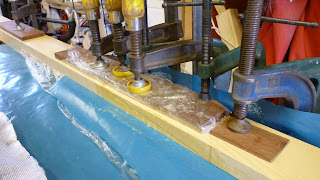Sunday, 11 November 2012
Time for another home built boat
So this time the project is a Greenland Skin on Frame Kayak following the guidance in Christopher Cunningham's book on the subject and plenty of other research over the internet. My other boats have involved epoxy and detailed boat plans. In contrast this time I will be working with trunnels, artificial sinew and no design plans. This will be a new experience and one which I am looking forward to.
The only epoxy job in the entire build, scarfing planks together to get the length I need.
I am working with yellow cedar and plan to use green oak to form the many ribs of this kayak. The dimensions really will be made to measure and they will all be calculated in the traditional way using Anthropometric measurements based on me!
I have already spent some time researching the technique and sourcing materials and a few additional tools. It is strange how one thing can lead to another and having found a new really good weekly podcast, I came across the download on skin on frame, an interview which Dan does with Corey Freeman of skin boats. Next thing I know I have all the non timber materials, coating, fabric and sinew etc. on route to England from the states.
My garage is now turned into a workshop and the timber has also arrived. The yellow cedar releases a really nice smell as it is worked (much nicer than drying epoxy and better for me I guess).
I will be interested to hear from anyone else out there who has a similar project on the go. Anyway, happy building and another boat in the making to add to the fleet.
In between all this I intend to get some winter sailing in and some kayaking (so I will include a few other pictures along the way)!
Subscribe to:
Post Comments (Atom)


2 comments:
Looking forward to watching it progress and filming the launch!
Superb! I love your this blog. I'm a professional sailor and like to share a little bit. Your should try learning to determine the wind direction using your ears. Let the wind blow onto your back, then slowly turn your head left to right and back until you feel it "equalize" over your ears. Once you find that point, you now know the wind direction, and using this method, you can understand the wind more without having to use your eyes. thanks a lot!
**************
Animations of a boat hull psychosnail
Post a Comment